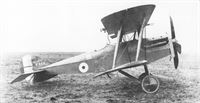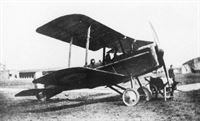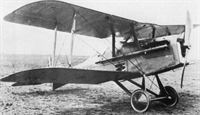Фотографии
-
Регистрационный номер: B4890 B4890 was one of the few S.E.5as to be fitted with narrow-chord elevators. It went to No 56 Squadron and was brought down on November 29 by Schubert of Jasta 6, its pilot, Lt Dodds becoming a PoW. It is seen after capture.
Самолёты на фотографии: RAF S.E.5 - Великобритания - 1916
-
Регистрационный номер: C1091 [2] C1091 with an experimental variable-pitch airscrew at RAE Farnborough, a picture dated April 26, 1920. In 1928 this S.E.5a joined the civil register as G-EBQQ.
Самолёты на фотографии: RAF S.E.5 - Великобритания - 1916
-
Регистрационный номер: E5923 E5923 at Martlesham Heath with extensively redesigned tail unit.
Самолёты на фотографии: RAF S.E.5 - Великобритания - 1916
-
Регистрационный номер: E5927 The title picture shows a ground-running test of the early fire-extinguishing equipment with which Sqn Ldr G. H. Norman experimented at Farnborough in 1920-21. The S.E.5a is E5927, and the picture is dated February 26, 1921.
Самолёты на фотографии: RAF S.E.5 - Великобритания - 1916
-
An S.E.5a of a Home Defence squadron in experimental camouflage with flame dampers on its exhaust pipes and a Hearne illuminated sight on its Lewis gun.
Самолёты на фотографии: RAF S.E.5 - Великобритания - 1916
-
The Noakes Landing Skid acted directly on an extension of the control column. Also shown is the post-war steel-tube undercarriage with independently pivoted half-axles.
Самолёты на фотографии: RAF S.E.5 - Великобритания - 1916
-
Several experimental installations of parachutes were tested on S.E.5a’s with a view to their operational use. The method of stowing the Guardian Angel Type A was somewhat clumsy, as it was a static-line parachute.
Самолёты на фотографии: RAF S.E.5 - Великобритания - 1916
-
Регистрационный номер: D203 [2] D203 yet again, this time in May 1922 with an experimental aluminium exhaust manifold, fitted on the port side only.
Самолёты на фотографии: RAF S.E.5 - Великобритания - 1916
-
Регистрационный номер: B4891 Another of McCudden’s S.E.5a’s was B4891, to which he fitted the spinner of the LVG C.V that he shot down on November 30, 1917. The S.E. had shortened exhaust pipes, narrow-chord elevators and the three-strut undercarriage. It survived until McCudden crash-landed it on March 21, 1918, after sustaining combat damage.
Самолёты на фотографии: RAF S.E.5 - Великобритания - 1916
-
Регистрационный номер: B4897 B4897 is seen at Farnborough on November 17, 1917, two days after its approval. It had the “three-strut” undercarriage and a type T.28137 two-blade airscrew. Going to France on November 20, it served with No 80 Squadron and was struck off charge following the death in action of Lt A. W. Morey on January 24, 1918.
Самолёты на фотографии: RAF S.E.5 - Великобритания - 1916
-
Регистрационный номер: D203 [2] The protean D203 with reduced dihedral, narrow-chord ailerons, experimental fin and balanced rudder, independent-axle undercarriage and geared Hispano-Suiza with Viper twin-block radiator system and shortened exhaust pipes.
Самолёты на фотографии: RAF S.E.5 - Великобритания - 1916
-
Регистрационный номер: SC43153 In spite of ambitious production plans, S.C.43153 was the only all-American built S.E.5a to be completed. Its trials commenced on August 20, 1918.
Самолёты на фотографии: RAF S.E.5 - Великобритания - 1916
-
One of the two-seat trainer conversions that were made in 1918.
Самолёты на фотографии: RAF S.E.5 - Великобритания - 1916
-
Регистрационный номер: B4875 [2] In October 1917 B4875 was fitted with the Eeman triple mounting, carrying three Lewis guns firing upwards at an angle of 45°. The breeches of the guns were within the cockpit and a special centre section with three suitable slots was used; the gravity tanks were transferred to the leading edge of the starboard upper wing. The top decking ahead of the cockpit was deepened, a long extended windscreen was fitted, and transparent panels were let into the fuselage sides. The aircraft had the all-wood undercarriage.
Самолёты на фотографии: RAF S.E.5 - Великобритания - 1916
-
Several experimental installations of parachutes were tested on S.E.5a’s with a view to their operational use. The Mears parachute, which fitted into and under the rear top decking, was by far the neatest.
Самолёты на фотографии: RAF S.E.5 - Великобритания - 1916
-
Регистрационный номер: B4875 [2] A view of B4875’s cockpit, dated November 12, 1917. The three Lewis guns constituted a considerable hazard in the event of a crash, and there must have been a risk that ejected cartridge cases might foul the controls. The repositioning of instruments posed problems, and magazine changing in combat would have been almost impossible.
Самолёты на фотографии: RAF S.E.5 - Великобритания - 1916
-
Регистрационный номер: C1091 [2] C1091’s cockpit showing (lower right) the sliding control for the variable-pitch airscrew.
Самолёты на фотографии: RAF S.E.5 - Великобритания - 1916
Статьи
- -
- Fairey Firefly Mark 5 /Preservation Profile/ (54)
- News Spotlight
- Personal album
- Skywriters
- ??? - 'Classy Chassy'
- ??? - The Red Baron
- A.Blythe - Handley Page rotary lift projects
- A.Hitchman - Auster ancestry (2)
- B.Gunston - Short's experimental Sherpa
- B.Martin - Britain's civil aircraft register
- J.Bruce - S.E.5: Fighter supreme (6)
- L.Hendrix - How to bellyland a Thunderchief
- P.Jarrett - Fitzgerald the flightless
- R.Riding - Comper Kite /British pre-war ultralights/
















